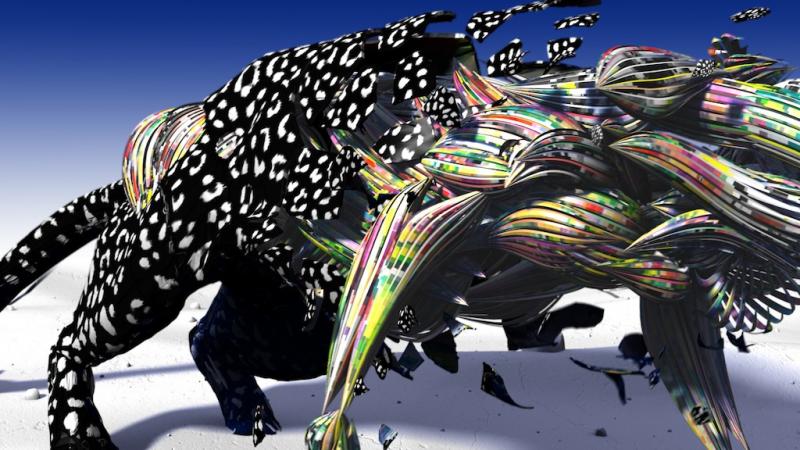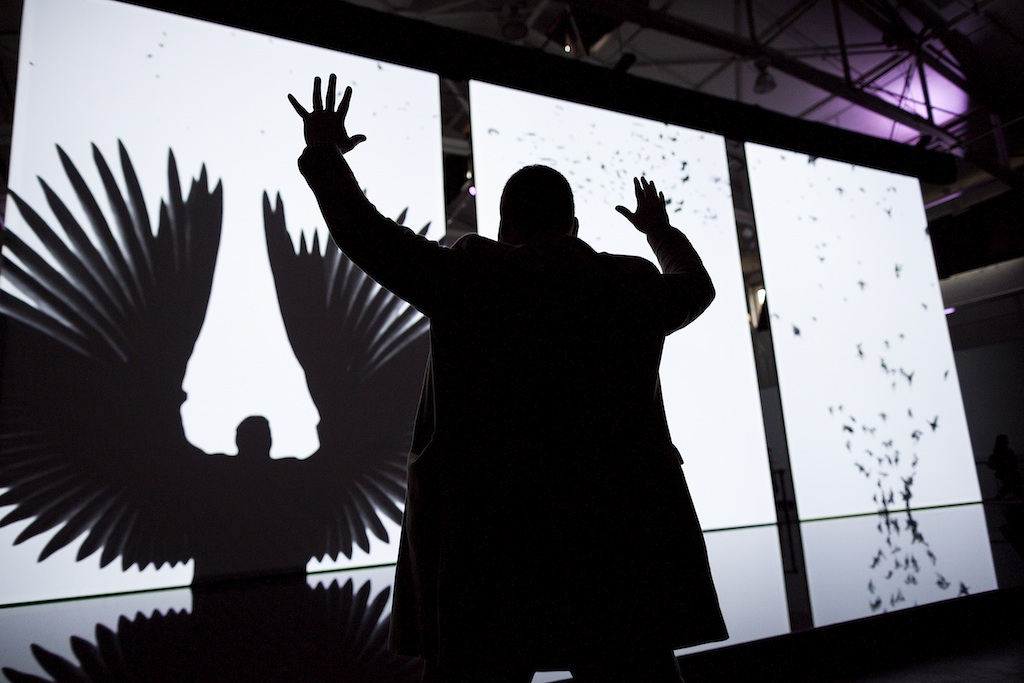Digital Revolution, The Curve, Barbican | reviews, news & interviews
Digital Revolution, The Curve, Barbican
Digital Revolution, The Curve, Barbican
A trip for techies down memory lane, plus a glimpse at the 'interactive' future

Digital Revolution begins with an archive section taking you back to the 1970s when Ralph Baer developed a video game allowing punters to play ping pong on TV (below right: poster for the original Pong arcade game) and Steve Jobs worked on Break Out, in which a virtual ball bounces off a bank of horizontal lines.
 The Quantel Paintbox of 1981 is among many other seminal machines on show; it was used by Dire Straits to make their award-winning pop video Money for Nothing, which unfortunately is not on view. Within 10 years, the CGI juke box had become an essential piece of kit; it was used for special effects such as the shape-shifter who materialises from pools of liquid metal in James Cameron’s sci-fi classic, Terminator 2 (1991), and the dinosaurs that run amok in Steven Spielberg’s Jurassic Park (1993). Miraculous as these creatures are, they still lack physicality. Despite their graphic sophistication, none is imbued with a realistic degree of density or heft; dinosaurs supposedly weighing several tons skip as lightly over the grass as tissue-paper toys and snap up victims seemingly as wafer-thin as fortune cookies.
The Quantel Paintbox of 1981 is among many other seminal machines on show; it was used by Dire Straits to make their award-winning pop video Money for Nothing, which unfortunately is not on view. Within 10 years, the CGI juke box had become an essential piece of kit; it was used for special effects such as the shape-shifter who materialises from pools of liquid metal in James Cameron’s sci-fi classic, Terminator 2 (1991), and the dinosaurs that run amok in Steven Spielberg’s Jurassic Park (1993). Miraculous as these creatures are, they still lack physicality. Despite their graphic sophistication, none is imbued with a realistic degree of density or heft; dinosaurs supposedly weighing several tons skip as lightly over the grass as tissue-paper toys and snap up victims seemingly as wafer-thin as fortune cookies.
Directed by Kerry Conran in 2004, the science fiction film Sky Captain and the World of Tomorrow was one of the first major features shot entirely on a digital backlot, blending live actors with computer generated surroundings; but the CGI is so glaringly obvious that precious little of the hoped-for fusion occurs.
The high point are clips from Alfonso Cuarón’s disaster movie Gravity, which proves that CGI can produce believable results – perhaps because much of the action takes place in outer space where zero gravity makes everything weightless anyway. The actors’ faces are real, but the other 95 percent of the film was animated by Tim Webber and his team at the Soho based studio, Framestore. Having taken them three and a half years to make, the film won a BAFTA for best visual effects and in March scooped seven Academy Awards.
 The enormous effort needed to achieve this degree of realism indicates just how young the technology still is. And focusing largely on experimental projects, the rest of the exhibition demonstrates the sad fact that technological innovation is no guarantee of an interesting outcome. Pioneering software frequently produces banal results.
The enormous effort needed to achieve this degree of realism indicates just how young the technology still is. And focusing largely on experimental projects, the rest of the exhibition demonstrates the sad fact that technological innovation is no guarantee of an interesting outcome. Pioneering software frequently produces banal results.
A new commission from music artist will.i.am and artist Yuri Suzuki results in what claims to be “an immersive sonic and visual installation sitting in the crossroads of yesterday and the now, leaping into the future.” Dominating the space is a mask-like, Tutankhamun-style head that slowly morphs as the singer croons a banal ditty called Dreamin’ About the Future accompanied by three digitised instruments housed in Perspex pyramids. Judging by this crass effort, the future looks set to be noisy and clichéd-ridden.
The press release emphasises the interactive aspect of the newly commissioned pieces; at best, though, they offer mildly interesting distractions but little agency. Whisper a wish into Varvara Guljajeva and Mar Carnet’s Wishing Wall and you generate a virtual butterfly that joins the others floating about the large screen. Stand in Chris Milk’s installation (Treachery of Sanctuary, 2012 pictured above left) and large wings are added to your silhouette; if you flap your arms vigorously enough, your image travels up the screen towards a virtual flock of birds, but the experience falls far short of flying.
 Stand in a cone of projected light in Umbrellium’s installation in the Pit (Assemblance pictured right), and you can manipulate the beams with your arms; this is mildly amusing, but of limited appeal since all you change are the ephemeral light patterns thrown onto the floor. The robotic arms of Petting Zoo by Minimaforms resemble elephants’ trunks and reach towards you in much the same way. They’ll come in handy when we’ve killed all the real elephants.
Stand in a cone of projected light in Umbrellium’s installation in the Pit (Assemblance pictured right), and you can manipulate the beams with your arms; this is mildly amusing, but of limited appeal since all you change are the ephemeral light patterns thrown onto the floor. The robotic arms of Petting Zoo by Minimaforms resemble elephants’ trunks and reach towards you in much the same way. They’ll come in handy when we’ve killed all the real elephants.
Fashion studio CuteCircuit give us skirts dotted with LED lights programmed to wink in patterns and play videos; the batteries last up to four hours. Pauline van Dongen’s Solar dresses look like something out of Star Trek; they may be clichéd but at least they contain solar panels that generate electricity rather than waste it. The LED lights with which Katia Vega decorates her eyebrows and hair are far more fun, especially when activated by a wink.
By now, I felt bludgeoned by the banks of machines and competing visuals yet bored by the triteness of most of the offerings. Rather than addressing interesting questions or worthwhile issues, most of the exhibitors seem determined to divert us with trivia. I encountered nothing that opened my mind or engaged me for much more than a nanosecond – until, that is, I came across the latest project by the formidable Not Impossible Foundation.

Former Los Angeles graffiti writer Tempt One was confined to bed paralysed by Lou Gehrig’s disease, unable to communicate with the outside world. Not Impossible rose to the challenge by developing a device that responds to eye movements and attached it to a pair of cheap sunglasses. This EyeWriter (pictured above left) translated Tempt One’s blinks into commands that activated a laser and created a mural for him reading “Tempt”. Then they posted the info online so that anyone with the requisite skills can construct an EyeWriter and enable other paralytics to communicate using only eye movements. Inspiring projects like this give people the tools to change their world in significant ways.
The term “interactive” should mean genuine agency; so let's not be fobbed off with paltry offerings that make nothing happen except an irrelevant light flash or an annoying sound beep.
- Digital Revolution at The Curve, Barbican until 14 September
Overleaf: watch a trailer for the exhibition
Explore topics
Share this article
The future of Arts Journalism
You can stop theartsdesk.com closing!
We urgently need financing to survive. Our fundraising drive has thus far raised £49,000 but we need to reach £100,000 or we will be forced to close. Please contribute here: https://gofund.me/c3f6033d
And if you can forward this information to anyone who might assist, we’d be grateful.

Subscribe to theartsdesk.com
Thank you for continuing to read our work on theartsdesk.com. For unlimited access to every article in its entirety, including our archive of more than 15,000 pieces, we're asking for £5 per month or £40 per year. We feel it's a very good deal, and hope you do too.
To take a subscription now simply click here.
And if you're looking for that extra gift for a friend or family member, why not treat them to a theartsdesk.com gift subscription?

Add comment